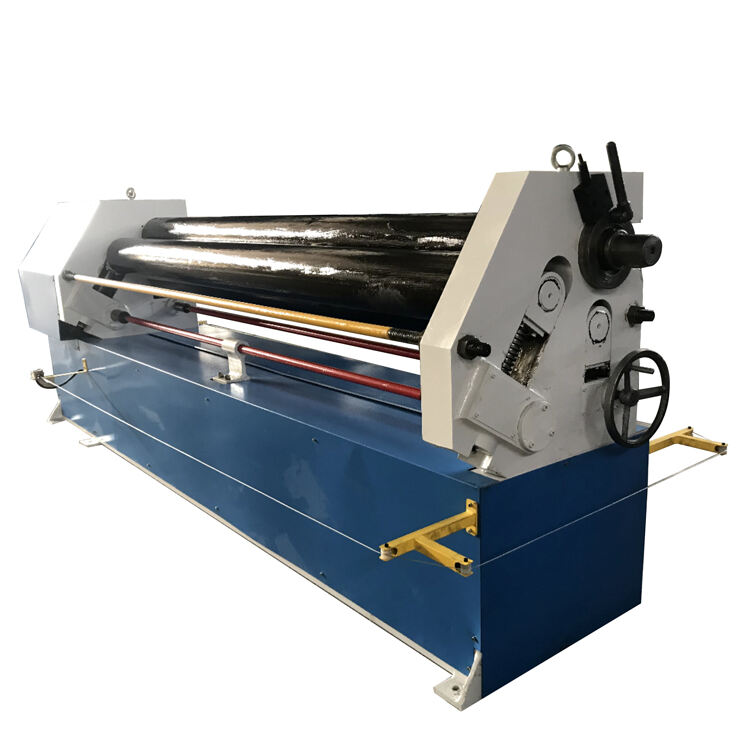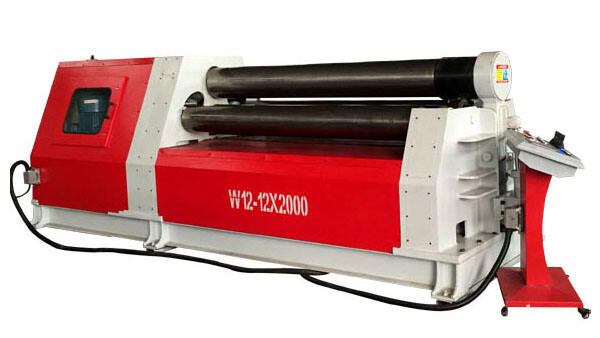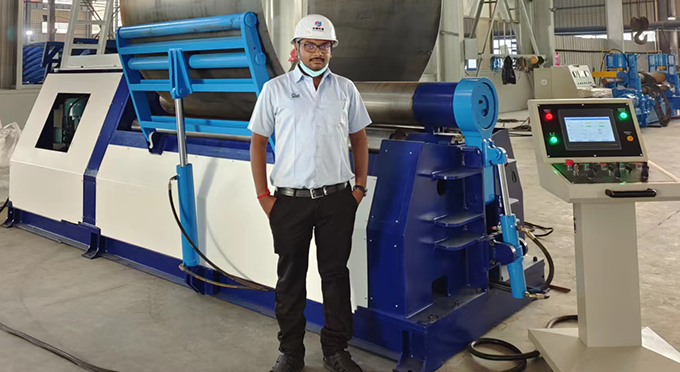Understanding Heavy-Duty Plate Rolling Machines
3-Roll vs. 4-Roll Plate Rolling Machines
It’s important to know the differences between 3-roll and 4-roll machines. The two systems are obviously based on different mechanisms for efficiently rolling the plate. The 3-roll machine is composed of a rolling top roll, with the bottom rolls counter rotating: in the pinch as the material is fed through the pinch the material will track as it hits the trailing edge of this third roll producing it to bend. The 4 roll machine has a constant pinch with the top roll directly behind the feed roll, thus allowing the material to be fed through the rolls.
-
Advantages of 4-roll Machines:
- These machines are known for achieving tighter radius bends compared to 3-roll systems. Enhanced automation and constant pinch lead to greater precision and productivity.
- Performance data from manufacturers indicate that 4-roll machines offer significant improvements in bending accuracy and efficiency over their 3-roll counterparts.
-
Versatility of 3-roll Machines:
- These machines are versatile, handling various sheet sizes and material types, making them popular across different industries.
- While the 3-roll system may require plate repositioning during the bending process, its ability to handle diverse applications such as cones and more complex shapes adds to its flexibility.
For more insights on these machines and their applications, check the 3-roll plate rolling machine and 4-roll plate rolling machine specifications from leading manufacturers.
Hydraulic vs. Mechanical Systems
When comparing hydraulic with mechanical plate rolling machines systems, a few crucial points are taken into consideration, namely operation, energy saving, and maintenance. Hydraulic systems are also preferred in thicker material industries as they can apply stronger force more efficiently; mechanical systems are known for their simplicity, making many of them suitable for lighter production requirements.
-
Hydraulic Plate Bending Machines:
- Offering superior force application, hydraulic systems excel in handling thicker materials. Case studies from heavy industries demonstrate their usage in settings that demand robust performance.
- These machines tend to be more energy-efficient compared to mechanical alternatives, providing cost savings in environments with high production rates.
-
Mechanical Systems:
- These systems come into their own in smaller workshops or applications with less demanding production needs. Their straightforward design makes them easier to maintain.
- Mechanical plate bending systems tend to excel in specific applications where precision and lower energy consumption are valued, despite lacking the advanced force capabilities of hydraulic systems.
Explore detailed specifications of hydraulic plate bending machine and mechanical systems for further comparison.
By understanding the mechanics and benefits of both types of plate rolling machines and systems, businesses can make informed decisions that best suit their operational requirements and production goals.
Key Features for Handling Tough Metal Bending
CNC Control and Precision Bending
CNC control technology has a significant effect on improving the precision of metal bending. CNC control: The CNC bending sequence control "automatically" controls the bending sequence, this guarantees repeatability and reduces the number of errors significantly. Sectors like aerospace and automotive can additionally benefit from this technology, as complicated shapes and tight tolerances are critical to businesses in these segments. For instance, CNC sheet bender machines enable production of complex parts required to be of high quality. And software integration also offers enhanced automation and digital control, allowing bending parameters to be fine-tuned and equal outputs produced while increasing productivity.
Force Management and Deflection Control
Today’s plate rolling equipment features sophisticated force control methods to maximize throughput while minimizing material deflection. These methods provide a more consistent process with less drag, even in high strength or alloy materials. Examples from real-world cases illustrate how deflection control systems improve quality of production through the preservation of material from the edge of the product to the exit side of the rolling mill. Companies processing difficult-to-form materials understand how force management and deflection control technologies contribute to producing high-quality and precise parts. It is very important to improve freeboard of the tank and minimize deflection in order to be in compliance with industry standards and meet customer requirements.
Heavy-Duty Roll Construction
Heavy Duty Rolls on Plate Rollers Produce Better Bends Plates rollers entailing heavy duty rolls are designed to last long, even in aggressive industrial applications. Robust and durable design solution is also key to maintain machine performance when exposed to harsh environments and usage. Standards and test methods dictate the construction of these machines, and all are built to satisfy industry requirements for durability. Some stats about machine life expectancy which underline the economic advantages using heavy duty roll construction. addressed, industry executives say, it makes a good long-term investment for companies as they save them the expense of over-frequent replacements, cut down on their overheads, and, ultimately, drive efficiency and profitability.
Applications in Industrial Metal Fabrication
Wind Tower and Pressure Vessel Production
MaterialsOn wind towers and pressure vessels, fine plate rolling is required to satisfy tight specifications on the material and bending. For wind towers that are too big and thickness also needs to be thick, heavy duty plate rolling machines are in demand. These keep the bends clean and meet the exact aerodynamic and structural specs. For pressure vessels, on the other hand, the rolls need to be highly repeatable in order to ensure the continued safety and integrity of the vessel, which are frequently codified by the appliance of the quite stringent ASME codes. These devices are designed to improve the bending, as well as maintain the safety and strength of the vessels.
Heavy duty plate rolling machines are used by a wide range of industries to speed up production and ensure safety regulations are met. For example, a case study of a partnership with a well-established energy company revealed the enormous potential of advanced rolling machines, by which they reduce the fabrication time from 30 to 70 % and achieve precision, a situation for which we have a safer and more efficient option. Such results prove the machines' fundamental role in productivity and safety in challenging industrial processes.
Shipbuilding and Structural Steel Bending
In shipbuilding field, plate rolling machine is an essential shaping machine to make all of those hulls. Those machines boast with the ability to do different types of bends that the curvy hull needs to improve the quality of the boat's structure and its hydrodynamic efficiency. Three-roll and four-roll machines, amongst other specific methods are regularly used in producing these bends, bringing their individual benefits according to shipbuilding requirements.
Heavy duty plate bending rolls are used for applications which have bending as well as rolling metal sections as a part of the process, for which lighter machines cannot be used as they restrict the size, these heavy duty plate bending machine takes large and heavy roll formation, elbow bend etc. They are adaptable to produce beams, girders, and other such structural shapes accurately. An interesting pattern about this industry is that automation is gaining more ground as a way to minimize the errors and energy wasted during the different manufacturing processes. Combining CNC control with automation is an increasing trend that offers improved accuracy for laser and plasma cutting as well as reduced labor costs in shipbuilding and in the structural steel industry, industry professionals have asserted. This change not only maximises efficiency, but also leads the industry to the era of intelligent manufacturing.
Selecting the Right Plate Rolling Machine
Material Thickness and Width Requirements
Material Thickness and Width Requirements : When choosing a plate rolling machine, the most important point is the maximum thickness and width of course. And this consists of machine ability to the projected application. Begin by correctly sizing material and understanding market requirements aligned with machine capabilities. For example, if a thin metal machine is used to make a thick material product, the machine frequently does not have the energy to effectively work the thick material and wastes energy as well as the product quality. Bad choices can result in expensive downtimes, wasted resources and less than ideal results. By abiding by recommendations based on material needs, manufacturers can maximize machine performance while also achieving high-quality product.
Pre-Bending Capabilities and Cone Rolling
Prebending is essential in accomplishing the accurate manipulation when rolling plates, particularly if geometrical complex parts are referred. Machines with such capabilities enable a variety of forms to be created without sacrificing accuracy or efficiency. Advances in cone rolling technology Cone rolling, an advanced process for producing conical shapes, is improved by the choice of machines with special features. Companies in sectors such as architecture and production are finding that a new production process has improved their ability to produce products. Focusing in on accuracy, they are the perfect forming equipment for projects that require precision - such as equipment for the water, oil and gas and nuclear industry.
Optimizing Performance and Safety
Maintenance Best Practices
How to Maintain Heavy Duty Plate Rolling Machine For your heavy-duty plate rolling machine to function optimally and prolong its service life, you will have to follow some maintenance practices. Routine checks are an important part of avoiding machine breakdowns and catching things before they grow into full-blown problems. Scheduling these checks and using quality spares can drastically lower the overall costs of maintenance. According to industry reports, preventative maintenance can offer a saving to the repair bill of between 20-30%, illustrating the cost-saving benefits of the approach to healthcare.
Some devices need to be regularly maintained, such as to lubricate or calibrate them as recommended by the product manufacturins. Attending to these responsibilities, not only increases the machine's performance, but it also increases safety and efficiency. Moreover, intensive instruction of employees in the operation of the machines is required. Trained staff are more likely to identify warning signs and also complete regular maintenance to help the machine run more efficiently.” So these procedures should be followed to ensure machine-life and dependability.
Operator Safety Protocols
Plate rolling machines require the safety of the operator and observation of safety measures in order to reduce the risk of injury or accidents. It begins with good training, which guarantees that the operator knows how the machine works and is familiar with its safety equipment and emergency procedures. Personal Protective Equipment (PPE) like gloves, helmets, and glasses are a must-have for anyone working in hazardous conditions.
The practice should be repeated and training sessions should be scheduled to adapt to any changes in the standard of safety at regular intervals. Many workplace accidents are caused by human error, poor training or failure to wear correct PPE, including existing published human error statistics. Looking into real incidents can really help show what the destruction could be if youbad safety rules. Safety organisations in the industry stress the importance of unyielding compliance with safety procedures, noting individual instances when safety failures resulted in severe injuries or long hours of downtime. In such an environment, the inclusion of an effective health and safety culture at the workplace is just as critical to the health of workers as it is to the continuous running of machinery.




